|
|
Electric
Snow Crystal Growth
... Using electric fields to alter the growth of snow crystals ... |
|
 Electric fields can affect the growth of ice crystals in
several interesting ways, and can be used to grow long thin needles of crystalline ice
(see the Designer's
Page). The electric effects come about because electric fields influence the way
water molecules diffuse through the air in the vicinity of the ice surface. If we charge
up a growing crystal, then electrostatics dictates that strong electric fields will be set
up around the crystal. The fields and field gradients will be particularly strong near any
sharp points on the crystal. Since water molecules have an intrinsic electric polarizability, the electric fields tend to polarize the water molecules. If the field
also has a strong gradient, then the polarized molecules are attracted in the direction of
stronger fields. Electric fields can affect the growth of ice crystals in
several interesting ways, and can be used to grow long thin needles of crystalline ice
(see the Designer's
Page). The electric effects come about because electric fields influence the way
water molecules diffuse through the air in the vicinity of the ice surface. If we charge
up a growing crystal, then electrostatics dictates that strong electric fields will be set
up around the crystal. The fields and field gradients will be particularly strong near any
sharp points on the crystal. Since water molecules have an intrinsic electric polarizability, the electric fields tend to polarize the water molecules. If the field
also has a strong gradient, then the polarized molecules are attracted in the direction of
stronger fields.
We analyzed dendrite
growth in the presence of an applied voltage [1], for the special case where the growing
crystal has no facets. This is simpler than the growth of real ice, but it seems to
describe the phenomenon quite well. For a small applied voltage, the dendrite looks about
the same as with no voltage, but the tip becomes sharper, and the tip growth velocity
increases. This is because electrically enhanced diffusion brings more molecules to the
high-voltage tip. The crystal surface tension stabilizes the growth in this case, just as
it does for growth without an applied voltage. (For information on normal dendrites see Snowflake
Branching.) |
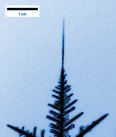 Once the
applied voltage reaches a certain critical value, however, the crystal growth becomes
unstable, and the tip velocity increases dramatically. The image at right shows an
electric needle growing out of a normal ice dendrite. A normal dendrite first was
grown on a metal wire, and allowed to reach a steady state, where it grew with a constant
tip velocity of about 3 microns/sec. Then a voltage was applied to the wire, and
voltage slowly increased with time. As the voltage increased the dendrite tip
velocity increased until at 1300 volts it was growing at about 4 microns/sec. The
dendrite continued to produce sidebranches as the voltage increased. At 1400 volts
an electric needle shot out from the dendrite tip at about 30 microns/sec and kept growing
at that velocity. Once the
applied voltage reaches a certain critical value, however, the crystal growth becomes
unstable, and the tip velocity increases dramatically. The image at right shows an
electric needle growing out of a normal ice dendrite. A normal dendrite first was
grown on a metal wire, and allowed to reach a steady state, where it grew with a constant
tip velocity of about 3 microns/sec. Then a voltage was applied to the wire, and
voltage slowly increased with time. As the voltage increased the dendrite tip
velocity increased until at 1300 volts it was growing at about 4 microns/sec. The
dendrite continued to produce sidebranches as the voltage increased. At 1400 volts
an electric needle shot out from the dendrite tip at about 30 microns/sec and kept growing
at that velocity.
We believe the electric needle forms because surface tension can
no longer
stabilize the needle growth, which must be stabilized by some other mechanism. We're
not sure what this is, but the leading candidate is tip heating: molecules condense on the
tip and heat it up, which prevents the tip from growing too rapidly.
|
  Electric fields also have other odd effects on ice crystal growth. For
example, the dendrite at right was grown essentially like the one above. However,
when the applied voltage reached a threshold value, no electric needle formed.
Instead the tip split; in fact it split, and then the two front branches split
again. What happened is that the crystal axis rotated 30 degrees; at the first
split, vertical in the image went from a [2 -1 -1 0] axis to a [1 0 -1 0] axis (see the Snowflake Primer).
We don't know why this rotation took place, but it happened at just the threshold voltage
where normal growth became unstable. This behavior remains a mystery. The
second image shows a side view taken just after the first image.
Electric fields also have other odd effects on ice crystal growth. For
example, the dendrite at right was grown essentially like the one above. However,
when the applied voltage reached a threshold value, no electric needle formed.
Instead the tip split; in fact it split, and then the two front branches split
again. What happened is that the crystal axis rotated 30 degrees; at the first
split, vertical in the image went from a [2 -1 -1 0] axis to a [1 0 -1 0] axis (see the Snowflake Primer).
We don't know why this rotation took place, but it happened at just the threshold voltage
where normal growth became unstable. This behavior remains a mystery. The
second image shows a side view taken just after the first image.
|
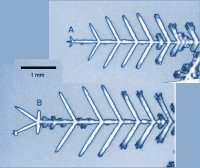 The image at left is another composite
view (enhanced to show detail) of a tip-splitting dendrite. This time as the voltage
approached the threshold value, the sidebranches became evenly spaced (compared to the
last image). Another mystery! The image at left is another composite
view (enhanced to show detail) of a tip-splitting dendrite. This time as the voltage
approached the threshold value, the sidebranches became evenly spaced (compared to the
last image). Another mystery!
|
  The images at right show what happens when a high voltage, above the
threshold value, is applied to an ice covered wire. Sharp points on the ice
crystals quickly develop ice needles, which grow out, occasionally splitting and changing
direction as they grow.
The images at right show what happens when a high voltage, above the
threshold value, is applied to an ice covered wire. Sharp points on the ice
crystals quickly develop ice needles, which grow out, occasionally splitting and changing
direction as they grow.
|
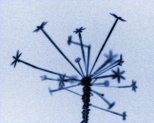 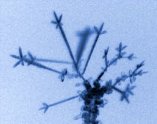 
|
Removing the applied voltage allows one
to see the crystalline axis of the electric needles, as can be seen in the above three
images [2]. The first set was grown at a high supersaturation, which produced a lot
of electric needles. These needles were grown at -5 C, and most grew along the
c-axis. After the voltage was turned off, and the whole collection of needles was
moved to a place in the growth chamber at -15 C. At that point snow stars grew at
the ends of all the needles.
For the second image the wire was placed at -15 C before the high voltage was
applied. A collection of electric needles grew from the wire, each along an a-axis.
When they got long, the voltage was removed, and normal growth resumed at the
needle tips, revealing the crystallographic orientation.
The electric needles in the third image were grown at an intermediate
temperature. When the field was removed, and the needles moved to -15 C, their
subsequent growth revealed that the needles each grew along a [1 0 -1 0] direction. |
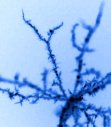 Finally, we find that at very high voltages the
electric needle growth itself becomes unstable, resulting in the erratic growth shown at
right. Finally, we find that at very high voltages the
electric needle growth itself becomes unstable, resulting in the erratic growth shown at
right.
We are currently mapping out the electric needle morphology as a function of
temperature, supersaturation, and voltage, in order to understand this phenomenon better. |
|
| [1] "Electrically Induced Morphological
Instabilities in Free Dendrite Growth," K. G. Libbrecht and V. M. Tanusheva, Phys.
Rev. Lett. 81, 176 (1998). [2] J. T. Bartlett,
A. P. van den Heuval, B. J. Mason, Z. angue. Math. Phys. 14, 509
(1963). |
|
